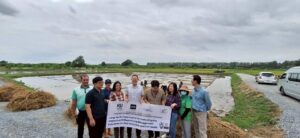
Research is currently underway to evaluate and adapt center-pivot sprinkler systems to rice production. The impetus for this research is threefold: to reduce the water required to produce rice, to expand the geographic area suitable for rice production, and, finally, to reduce the cost of overall production by automating irrigation operations and fertilizer and chemical applications.
Center-pivot sprinkler systems have many advantages over other forms of irrigation. They apply water much more uniformly to fields than do either flood or furrow irrigation; and, since pumping requirements are reduced, water outflows are lessened allowing farmers to save on both water and energy. Moreover, another added benefit is, fertilizers and chemicals can be applied through the center-pivot system with the same high efficiency as the irrigation water. This can significantly reduce labor and application costs. The loss of fertilizers and chemicals to leaching and runoff is minimized, thereby increasing input efficiencies and reducing potential environmental impacts. Furthermore, in-season application of nutrients (particularly nitrogen) through fertigation enables plants to better utilize the nutrients, as the system matches the plant need and uptake.
Center-pivot systems perform well on sloped fields of up to 30 degrees, which eliminate the cost of expensive land leveling operations. Additional cost savings can be realized from reductions in labor and expenses for land repair, heavy tillage, puddling, lateral canal construction, surface smoothing, and check (bund) construction and maintenance. Expansion of rice ground without expensive land development can occur by using center-pivot systems. Areas previously unsuitable for rice production due to topographic or soil type constraints may now be considered for cultivation. Sloped fields, uneven ground, and lighter textured soils could all be put into rice production.
Established rice paddies are suitable only for rice production. To rotate rice with other crops can be difficult or impossible. The use of center-pivot systems would help facilitate crop rotation for healthier crops and soils. It would also make farmers more flexible to respond to changes in markets, weather, and other conditions. Because a field irrigated by a center-pivot system does not require maintaining flood water, puddling operations, which make crop rotation difficult would be eliminated.
From a “green perspective,” published estimates place the methane production of rice paddies at between 50 and 100 million tons per year. Greenhouse gas emissions could be reduced by not flooding and water logging rice soils. In addition, reducing the number of flooded fields would reduce breeding areas for mosquitoes.
Research performed in Missouri and Arkansas in the United States and in Brazil has shown that irrigating rice with a center-pivot system reduces water applications from 28 to 50% compared with conventional flood methods, while maintaining or improving rice yields. Reported yields from these studies have been between 6 and 8 tons per hectare.
Because a center-pivot irrigated field is never flooded, early season rains are less likely to drown direct-seeded rice as it germinates. This was documented this season in field trials in Arkansas. While paddy fields had to be replanted due to excessive spring rains, the center pivot irrigated field sustained very little damage. Plus, center-pivot irrigated fields will dry out more quickly at the end of the growing season allowing harvest equipment into the field sooner. Also, earlier harvesting will reduce yield losses from seed-head shatter, lodging, and pests.
A number of factors do have to be taken into account when considering the use of center-pivot systems for rice irrigation. The use of blast resistant rice varieties is essential as overhead sprinkler systems will regularly wet the rice canopy. Increased dependence on herbicides will also occur without flood water to keep weeds in check. Herbicide and fungicide programs will have to be carefully monitored. The cost of these programs should be offset by reduced production and pumping costs, however.
Center-pivot sprinkler systems may not be applicable to every field and every situation, but the expectation is that, the advantages of center-pivot sprinkler irrigation can be successfully adapted to widespread rice production. More research is required to confirm the sustainability of rice yields in using this technology. Early indications, however, show that center pivot sprinkler systems will provide the same water, labor, and nutrient savings for rice as for other field crops.
_________________________________________
Mr. Onken is the director of Application Engineering and Education for the Lindsay Corporation based in the United States.










can i grow rice successfully under center pivot irrigation.
i read so many information on rice growing , and different irrigation systems.
but never read how to do it under center pivot.
please help with the understanding , can i sucsesfully grow rice under center pivot , like i grow maize and wheat.
please help
best regards dana zimbabwe
rice under center pivot.
what is my weekly requirement.
can you kindly send me a graph of water requirement as per week 1
2
3
4
5
ect.
please.do i need to apply water equal to maize.
like 700
800
900 mm per year.
please , i think the water requirement , from emerging to harvest should explain. Many thanks ,best regards dana Zimbabwe